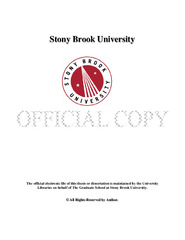| dc.identifier.uri | http://hdl.handle.net/1951/59895 | |
| dc.identifier.uri | http://hdl.handle.net/11401/71443 | |
| dc.description.sponsorship | This work is sponsored by the Stony Brook University Graduate School in compliance with the requirements for completion of degree. | en_US |
| dc.format | Monograph | |
| dc.format.medium | Electronic Resource | en_US |
| dc.language.iso | en_US | |
| dc.publisher | The Graduate School, Stony Brook University: Stony Brook, NY. | |
| dc.type | Thesis | |
| dcterms.abstract | Iron sulfur proteins are the most commonly known proteins in all living organisms. The active sites of some iron sulfur protein are clusters that are the polynuclear combinations of iron and sulfur atoms. Iron-sulfur clusters perform various biochemical abilities, for example, electron transfer. Iron-sulfur clusters can also act as redox and non-redox catalysts. Creating model metal centers which mimic the electronic configuration of the active sites and the interaction between proteins is still an issue today. We decided to design simple and benzene thiols that imitate the side arm of cysteine (-CH<sub>2</sub>-SH-). Therefore, we developed the H<sub>3</sub>PS3 series ligands, one of which is H<sub>3</sub>(PS3*). H<sub>3</sub>(PS3*) (Tris(3-phenyl-2-thiophenyl)phosphine) ligand contains three substituted phenyl rings that are expected to form iron complexes with different geometries because of steric effects. Through the reaction of Li<sub>3</sub>(PS3*) with Fe<super>II</super>Cl<sub>2</sub> H<sub>2</sub>O in acetonitrile, the neutral Fe(II) complex , [Fe<super>II</super>(PS3*)<sub>2</sub>], was obtained unexpectedly in the attempt to synthesize an Fe(II)Fe(II) dimeric complex. By studying the X-ray structure of [Fe<super>II</super>(PS3*)<sub>2</sub>] we suggest that the original Fe(II) ion was oxidized to Fe(III) by unknown reasons and thus Fe(II) is regenerated by the oxidative coupling of two (PS3*)<super>3-</super> ligands via the formation of two organic-disulfide bonds. | |
| dcterms.available | 2013-05-22T17:35:43Z | |
| dcterms.available | 2015-04-24T14:47:35Z | |
| dcterms.contributor | Koch, Stephen A | en_US |
| dcterms.contributor | Lauher, Joseph W | en_US |
| dcterms.contributor | Aubrecht, Katherine B | en_US |
| dcterms.creator | Tsai, Jung-Chu | |
| dcterms.dateAccepted | 2013-05-22T17:35:43Z | |
| dcterms.dateAccepted | 2015-04-24T14:47:35Z | |
| dcterms.dateSubmitted | 2013-05-22T17:35:43Z | |
| dcterms.dateSubmitted | 2015-04-24T14:47:35Z | |
| dcterms.description | Department of Chemistry | en_US |
| dcterms.extent | 55 pg. | en_US |
| dcterms.format | Application/PDF | en_US |
| dcterms.format | Monograph | |
| dcterms.identifier | http://hdl.handle.net/1951/59895 | |
| dcterms.identifier | Tsai_grad.sunysb_0771M_10800 | en_US |
| dcterms.identifier | http://hdl.handle.net/11401/71443 | |
| dcterms.issued | 2011-12-01 | |
| dcterms.language | en_US | |
| dcterms.provenance | Made available in DSpace on 2013-05-22T17:35:43Z (GMT). No. of bitstreams: 1
Tsai_grad.sunysb_0771M_10800.pdf: 2439565 bytes, checksum: f85bc30a8e076b55c1d3bb762b5f18e2 (MD5)
Previous issue date: 1 | en |
| dcterms.provenance | Made available in DSpace on 2015-04-24T14:47:35Z (GMT). No. of bitstreams: 3
Tsai_grad.sunysb_0771M_10800.pdf.jpg: 1894 bytes, checksum: a6009c46e6ec8251b348085684cba80d (MD5)
Tsai_grad.sunysb_0771M_10800.pdf.txt: 50874 bytes, checksum: 7f6cc92d02c3c47f00c31c1ff2b9fc08 (MD5)
Tsai_grad.sunysb_0771M_10800.pdf: 2439565 bytes, checksum: f85bc30a8e076b55c1d3bb762b5f18e2 (MD5)
Previous issue date: 1 | en |
| dcterms.publisher | The Graduate School, Stony Brook University: Stony Brook, NY. | |
| dcterms.subject | Chemistry | |
| dcterms.subject | disulfide complex, iron | |
| dcterms.title | Synthesis of disulfide iron complexes | |
| dcterms.type | Thesis | |

